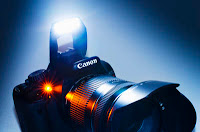 Recently, someone asked me to write an article for this blog on how to use pop-up flash to obtain natural looking photos. I have to admit that I do not use a pop-up flash very often due to its limitations. For one thing, it has a short range, usually around 12'. But worse than that, it is positioned on the camera so the light it throws is very harsh and directional, and casts hard shadows. This last feature is worsened when the camera is turned vertical so the shadow falls off to one side of the subject instead of down and behind where can be hidden. Nonetheless, I thought the project would be interesting to explore so here it is.
Recently, someone asked me to write an article for this blog on how to use pop-up flash to obtain natural looking photos. I have to admit that I do not use a pop-up flash very often due to its limitations. For one thing, it has a short range, usually around 12'. But worse than that, it is positioned on the camera so the light it throws is very harsh and directional, and casts hard shadows. This last feature is worsened when the camera is turned vertical so the shadow falls off to one side of the subject instead of down and behind where can be hidden. Nonetheless, I thought the project would be interesting to explore so here it is.
The real trick to using on-camera, pop-up flash correctly is in not allowing it to dominate the scene. When used as the major light source, the flash creates an artificial, flat, and overly bright light that destroys the natural ambiance of the scene. What we are going to try to do here is look at methods of applying the flash to enhance the naturally lit scene rather than dominate it.
Let's examine some of the uses for on-camera flash as an auxiliary light source.
Outdoor fill flash:
It might seem counter intuitive to use a flash outdoors on a sunny day, but this is a situation that can benefit the most. Harsh shadows on the face from a strong overhead sun can ruin an outdoor portrait. The difference in exposure between the bright highlights and deep shadows is so great that important detail may be lost in one or both areas. There are two ways of dealing with this, both involve what is known as "fill flash". When the subject is facing into the sun, flash fill can be used to brighten the shadows and equalize the exposure between them and the highlights.
Light from most built-in flash units are of very low power so you may need to use them in close to achieve full benefit. Over powering the sun is no small task.
A better solution for an outdoor portrait might be to turn the person to face away from the sun. This puts them in a back lit situation, which is much easier to fill, and often more flattering.
 |
| Positioning the subject with the sun behind them results in a very flattering back lit scene. Using the on-camera flash here adds more detail to the face and a catch light to sparkle the eyes. |
Outdoor flash fill situations are usually very bright so determining proper exposure is primarily a matter of using your normal camera exposure, setting the flash on TTL, and allowing the camera/flash derive its own output. Working in the manual setting you can select the correct exposure reading for the overall scene. You don't have to worry about the shadows because this is the area that the flash is filling to bring its exposure up to the level of the overall scene.
You will need to check to see that you are not inadvertently overexposing the scene. Most cameras have an upper shutter speed limit at which a flash can be used. This may not be high enough to properly expose the scene. Often this is a result of the ISO being set to high, or may be a result of trying to use a lens aperture setting that is too open.
Indoor flash fill:
Indoor flash fill is usually not as necessary as outdoor fill, but it may add clarity and detail to the subject. In addition, it will add a flattering "catch light" in the subjects eyes. Catch light is the bright dot of light that is reflected in the subjects eyes making them sparkle.
An indoor situation that might require flash fill would be one where the available light is sufficient to take the picture, but the shadow exposure is beyond the range of an overall even exposure. Filling the shadows with light is similar to outdoor flash fill, although a major difference, light intensity, will likely be much less and may lead to overexposing the subject. Care must be taken to achieve an overall even exposure that does not washout the background.
 |
| Even though you can take a photo indoors without a flash, you may want to add it to create a more even, flattering light. |
Slow synch flash:
This technique is used when the background scene is very dark relative to the foreground subject, as with a person photographed against a night city scene, or a person photographed indoors where the scene is quite dark. Slow synch derives its name from the slow shutter speed necessary to allow the background to record more naturally in the photograph. Typically, on most cameras, particularly when using them in auto setting, the flash is synchronized to a shutter speed between 1/60 - 1/250 second. The flash will only function at a speed slower that this synch speed, and the camera tries to use the highest synch speed available. This is much too fast to record any detail in a dark scene.
 |
| A scene like this is very difficult to light and achieve a natural look. Typically, the scene would be dark and the warm glow from the candles would be lighting the subjects face. Pop-up flash distorts the natural feel of the scene and produces an false interpretation of the scene. Direct, on-camera flash gives off a harsh, directional light that produces distinct shadows, particularly when the camera is in a vertical position as it is here. Furthermore, the color of the flash light seems false because it is balanced for daylight, while the scene itself usually has a warm, yellow glow associated with indoor lighting. Finally, the flash completely overpowers the light from the candles falling on the subjects face. |
In order to achieve a more natural look that harmonizes the background exposure with the foreground subject receiving light from the flash, it is necessary to decrease the shutter speed to a point where the background brightens up to normal exposure. This may result in a very slow shutter speed, one that will normally blur a photo. Since the flash is lighting the primary subject, it is not contributing any blur from the slow shutter. Only those areas receiving no light from the flash are subject to blurring. So slow synch flash is a technique where a shutter speed slow enough to record the background properly is combined with the on-camera flash lighting the main subject. You want to try to harmonize the two lights.
Many modern cameras have a mode setting for accomplishing slow-synch flash automatically, but they do not always work properly because they are not tied into the nuances of the variety of scenes you may come across. Furthermore, in these auto modes the camera selects both shutter speed and aperture. You might want to use a different aperture for creative reasons,as we did in the sample below.
To accomplish slow synch flash yourself, set the camera to "M" for manual mode. Select an aperture setting that you find works best -- wide open to blur the background, or stopped down to bring the background more into focus. Take a light reading of the background scene, but select a shutter speed that will under-expose it approximately 1 1/2 stops. Keep your flash in TTL mode so the camera will determine the correct amount of flash to deliver onto the foreground subject. Take a test photo and examine it. If you would like to have the background brighter, slow the shutter speed a bit more. If you want it to be darker, increase the shutter speed.
Flash softening aides:
Direct light from the on-camera flash is very harsh and directional. It produces a false impression of the actual scene with a hard edged shadow, normal color balance, and unflattering detail. Slow synch already helps this, but using a diffusing element in front of the flash can help soften it more. I researched several inexpensive, commercially available devices to discover which would work best at producing the most natural light.
 |
| Number 1 is the Gary Fong Puffer. Number 2 is the Interfit small camera diffuser. Number 3 is the LumiQuest Soft Screen. |
 |
| Number 2 shows results from using the Interfit diffuser, and is the best of the three devices. The models shadow has completely disappeared and the light on her face is soft and even with no hot spots. Number 3, the LumiQuest is little better than using no diffuser at all. |
Flash diffusion works best when the diffusing surface is large and placed far enough away from the flash to spread out the light. When it is too close, it might be diffused but it is still directional and will cast a distinct shadow. As distance and diffusion surface increase the light is more evenly distributed and falls on the subject softly and naturally. In the samples above, one reflector, the Interfit small camera difuser, accomplishes this softening effect better than the others.
Conclusion:
In many situations an on-camera flash can supply the extra light needed to add detail to a dark scene or fill a harshly lit situation. Using the light properly is the key to success on whether the resulting photos have a false or natural look to them.
In a future article I will expand the use of camera flash by showing the use of more powerful, auxiliary flash units that can be used either on or off the camera, and can be used in tandem with other flash units.





Using Sticky Filters flash gels in the junior size will make your pop-up flash much more useful. www.stickyfilters.com
ReplyDelete